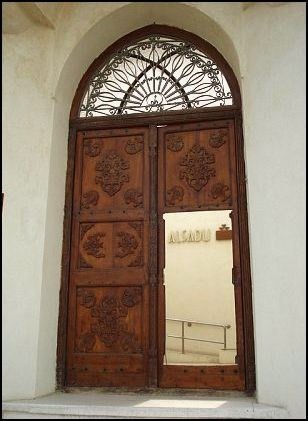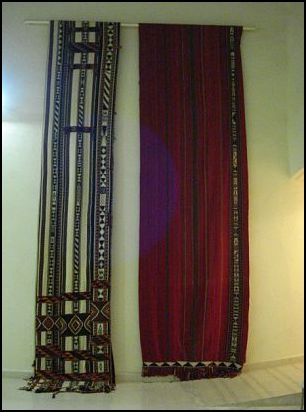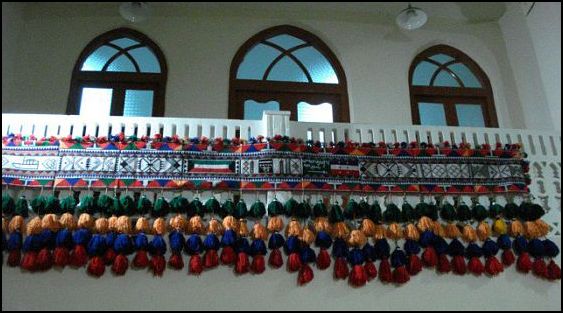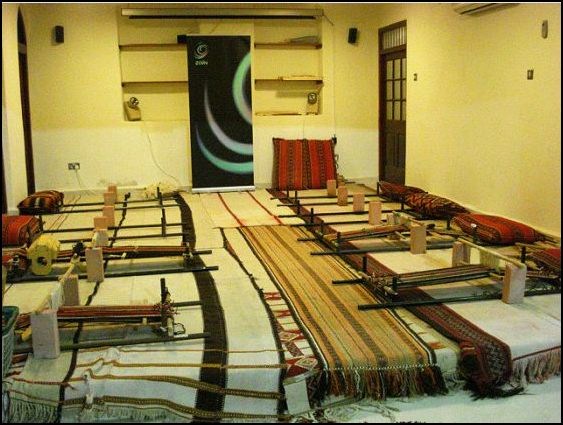
The Textiles of Sadu House
by Lilo Bowman
Quilters hold meetings in all sorts of places: churches, member homes, schools. I even have heard of a group of quilters in Alaska who meet in a local bar/diner! Generally, as long as there is enough light and space, most of us don’t give too much thought to the location itself. In Kuwait, however, when attending the monthly meeting of the KTAA (Kuwait Textile Arts Association) at the Sadu House, one can’t help but take notice of the stunning textiles and other household objects on display around them.
Sadu House (House of Weaving) was founded in 1979 by a small group of Kuwaiti women concerned that the long-standing Bedouin weaving tradition, called al sadu, was being lost. These Kuwaiti women joined forces with a group of Bedouin women to organize regular weaving lessons and demonstrations. The Bedouin women also were asked to produce specifically woven pieces that reflected a link to their tradition of living in harmony with the desert.

Traditional Bedouin Weavings. Photo by Alanna Petrusich
Some background: The Bedouin people have lived up until recently in the desert for hundreds of years (bedu means "inhabitant of the desert"), following the rhythms of the seasons, and their weaving designs directly reflected the elements of nature surrounding them. Weaving was and has been an integral part of Bedouin tribal life, and a skilled weaver was vital to the function and comfort of the household. As with other cultures that make a living from their land and livestock, the women made use of the materials around them--the natural fibers from sheep, camels, and goats, as well as desert plants--to produce utilitarian household items that at the same time demonstrated their personal talents. Their weaving produced almost everything remotely textile related for the household, including cushions, storage bags, rugs, cords for tying up livestock, and elements for tents.

Photo by Alanna Petrusich
Tents were generally divided into two areas: a sitting area for men and visiting guests, called the mag’ad, and the area designated for cooking and female guests, called the maharama. A woven curtain, called the ma’nad, was used to separate these two areas. This curtain would be very elaborate in design, incorporating many colorful patterns, and--again--would showcase the skills of the woman who made it.

Weaving looms. Photo by Alanna Petrusich
Summer provided the best time to weave, as it was too hot for travel and the diminished humidity protected the wool. After the animals were shorn, the wool was sorted by color, with some set aside for dyeing in bright red and orange. These bright colors gave a bit of punch to the more subtle black, white, brown, and tan of the natural wools. The wool then would be spun and the intricate process of weaving would begin.
Today under the patronage of Sheikha Altaf, Sadu House stands as a testament to the preservation of the rich and colorful tradition practiced by the Bedouin. The house itself was designed to reflect a typical Gulf-style home, that is, it is built around a central courtyard. Usually this central courtyard would be open to the elements. However, in this case, the original courtyard has been covered with a glass roof to admit light while protecting the interior. Inside the house, you will find displays of stunning textiles, tents, ceramics and pottery, and various decorative household objects. There is even a re-created roofed children’s playground.
Traditionally, during the hot summer months, family members would live in the north and east portions of the home. In winter, they would move to the south and west portions of the home. This back-and-forth movement made the space most comfortable in a time without air conditioning.
To see more of Sadu House, watch the slideshow. (Originally part of another series)
 |




.jpg)



RSS feed for comments to this post